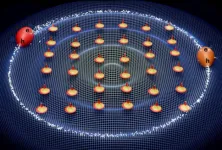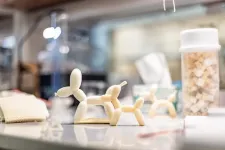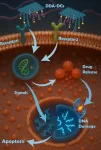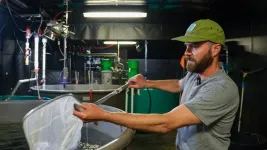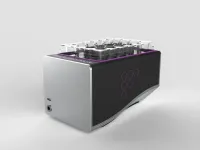(Press-News.org) Groundbreaking research by physicists at The City College of New York is being credited for a novel discovery regarding the interaction of electronic excitations via spin waves. The finding by the Laboratory for Nano and Micro Photonics (LaNMP) team headed by physicist Vinod Menon could open the door to future technologies and advanced applications such as optical modulators, all-optical logic gates, and quantum transducers. The work is reported in the journal Nature Materials.
The researchers showed the emergence of interaction between electronic excitations (excitons – electron hole pairs) mediated via spin waves in atomically thin (2D) magnets. They demonstrated that the excitons can interact indirectly through magnons (spin waves), which are like ripples or waves in the 2D material’s magnetic structure.
“Think of magnons as tiny flip-flops of atomic magnets inside the crystal. One exciton changes the local magnetism, and that change then influences another exciton nearby. It’s like two floating objects pulling toward each other by disturbing water waves around them,” said Menon.
To demonstrate this, the Menon group utilized a magnetic semiconductor, CrSBr which the group had previously shown to host strong light-matter interaction (Nature, 2023).
Post-doctoral fellows Biswajit Datta and Pratap Chandra Adak led the research along with graduate students Sichao Yu and Agneya Dharmapalan in collaboration with the groups at the CUNY Advanced Science Research Center, University of Chemistry and Technology – Prague, RPTU - Kaiserslautern, Germany and NREL, USA.
“What is especially exciting about this discovery is that the interaction between excitons can be controlled externally using a magnetic field, thanks to the tunable magnetism of 2D materials. That means we can effectively switch the interaction on or off, which is hard to do with other types of interactions,” said Datta.
“One particularly exciting application enabled by this discovery is in the development of quantum transducers - devices that convert quantum signals from one frequency to another, such as from microwave to optical. These are key components for building quantum computers and enabling the quantum internet.” said Adak, another lead author of this work.
The work at CCNY was supported by U.S. Department of Energy – Office of Basic Energy Sciences, The Army Research Office, The National Science Foundation and The Gordon and Betty Moore Foundation.
Citation: Datta, B., Adak, P.C., Yu, S. et al. Magnon-mediated exciton–exciton interaction in a van der Waals antiferromagnet. Nat. Mater. (2025). https://doi.org/10.1038/s41563-025-02183-0
END
CCNY physicists uncover electronic interactions mediated via spin waves
2025-04-03
ELSE PRESS RELEASES FROM THIS DATE:
Researchers’ 3D-printing formula may transform future of foam
2025-04-03
From seat cushions to mattresses to insulation, foam is everywhere — even if we don’t always see it.
Now, researchers at The University of Texas at Dallas have fused chemistry with technology to create a 3D-printed foam that is more durable and more recyclable than the polymer foam found in many everyday products.
The research, which appears in the March 1 print edition of RSC Applied Polymers, a journal of the Royal Society of Chemistry, focused on creating a sturdy but lightweight foam that could be 3D-printed, a method that is still largely unexplored in commercial manufacturing, said the study’s co-lead author, UT Dallas doctoral student Rebecca Johnson ...
Nurture more important than nature for robotic hand
2025-04-03
How does a robotic arm or a prosthetic hand learn a complex task like grasping and rotating a ball? The challenge for the human, prosthetic or robotic hand has always been to correctly learn to control the fingers to exert forces on an object. The sensitive skin and nerve endings that cover our hands have been attributed with helping us learn and adapt our manipulation, so roboticists have insisted on incorporating sensors on robotic hands. But–given that you can still learn to handle objects with gloves on– there must be something else at play.
This mystery is what inspired researchers in the ValeroLab in the Viterbi School of Engineering ...
Drug-delivering aptamers target leukemia stem cells for one-two knockout punch
2025-04-03
CHAMPAIGN, Ill. — Drug-carrying DNA aptamers can deliver a one-two punch to leukemia by precisely targeting the elusive cancer stem cells that seed cancer relapses, researchers at the University of Illinois Urbana-Champaign report.
The aptamers — short single-strand snippets of DNA that can target molecules like larger antibodies do — not only deliver cancer-fighting drugs, but also are themselves toxic to the cancer stem cells, the researchers said.
Led by Xing Wang, a U. of I. professor of bioengineering and of chemistry, the researchers documented their findings in the journal Advanced Functional Materials.
“This ...
New study finds that over 95% of sponsored influencer posts on Twitter were not disclosed
2025-04-03
New INFORMS journal Marketing Science Article Key Takeaways:
Over 95% of sponsored influencer posts on Twitter were not disclosed.
Influencer sponsorship arrangements with younger brands are less likely to be disclosed.
A large number of consumers can’t detect the sponsorship arrangement without disclosure.
The consumer-protection regulatory environment around undisclosed sponsorships has lagged behind.
BALTIMORE, MD, April 3, 2025 – New research in the peer-reviewed journal Marketing Science has found that 95% of influencer posts on Twitter (now X), which are sponsored, are not disclosed.
The ...
New sea grant report helps great lakes fish farmers navigate aquaculture regulations
2025-04-03
DULUTH, Minn.–Fish farmers across the Great Lakes states can face a confusing web of permits, policies and regulations that can hinder the growth of their operations. A new Sea Grant publication, Aquaculture Regulations in the Great Lakes, offers much-needed clarity.
The report breaks down complex legal frameworks and provides practical insights to help aquaculture producers understand and navigate state and regional requirements with greater confidence. It was developed by the National Sea Grant Law Center (NSGLC) ...
Strain “trick” improves perovskite solar cells’ efficiency
2025-04-03
Solar energy is one of the most promising solutions for reducing our dependence on fossil fuels. But making solar panels more efficient is a constant challenge. Perovskite solar cells (PSCs) have been a game-changer, offering rapid improvements in efficiency and potential for low-cost manufacturing. However, they still suffer from energy losses and operational stability issues.
The challenge with wide-bandgap perovskites
Perovskite solar cells, particularly those used in tandem configurations, rely on wide-bandgap (WBG) materials—semiconductors that absorb higher-energy ("bluer") ...
How GPS helps older drivers stay on the roads
2025-04-03
How GPS helps older drivers stay on the roads
Peer reviewed – observational study - humans
Sat Nav systems help keep older drivers on the roads for longer, according to new research from the University of East Anglia.
A new study published today reveals that over 65s with a poorer sense of direction rely more on help from GPS navigation systems such as Sat Nav or smartphone maps.
Those using GPS tended to drive more frequently - suggesting that the technology helps older people maintain driving independence.
Senior author Prof Michael Hornberger, from UEA’s Norwich Medical School, said: “Driving is usually the preferred mode of transport among ...
Estrogen and progesterone stimulate the body to make opioids
2025-04-03
Scientists have discovered a new mechanism that acts via an immune cell and points toward a different way of treating chronic pain.
Female hormones can suppress pain by making immune cells near the spinal cord produce opioids, a new study from researchers at UC San Francisco has found. This stops pain signals before they get to the brain.
The discovery could help with developing new treatments for chronic pain. It may also explain why some painkillers work better for women than men and why postmenopausal ...
Dancing with the cells – how acoustically levitating a diamond led to a breakthrough in biotech automation
2025-04-03
Engineers at a University of Bristol spin-out company have created a new technology that can move cells without touching them, enabling critical tasks that currently require large pieces of lab equipment to be carried out on a benchtop device.
The invention could accelerate the discovery of new medicines and unlock personalised medicine screening in clinics.
The groundbreaking concept was unveiled for the first time today in an article in Science published by Dr Luke Cox, where he describes his journey from University of Bristol ...
Machine learning helps construct an evolutionary timeline of bacteria
2025-04-03
University of Queensland scientists have helped to construct a detailed timeline for bacterial evolution, suggesting some bacteria used oxygen long before evolving the ability to produce it through photosynthesis.
The multinational collaboration – led by researchers from the Okinawa Institute of Science and Technology, the University of Bristol, Queensland University of Technology and UQ – focused on how microorganisms responded to the Great Oxygenation Event (GOE) about 2.33 billion years ago, which changed ...
